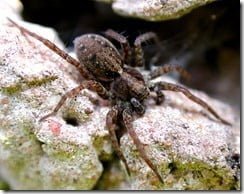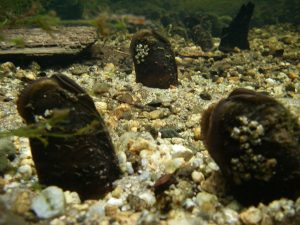If there is one type of creature that instils completely unwarranted fear into large numbers of people here in Ireland it has to be spiders. Such fear is completely unfounded, as none of the spider species found in Ireland are capable of harming humans in any way. If anything spiders perform an invaluable service in keeping down the number of insect pests in and around our homes.
Pardosa amentata is a common species of spider belonging to the family Lycosidae. Early naturalists observed large numbers of these spiders scurrying across the ground together, and it was once thought that they hunted in packs… hence the name. Wolf spiders are in fact solitary hunters, but the name has stuck, and is applied to members of the family around the world to this day.
Instead of using a web to ensnare its prey like other spiders, the wolf spider uses stealth, speed and excellent eyesight to actively hunt living prey. Pardosa amentata is a mottled brown wolf spider between 5mm and 8mm (about ¼ inch) in length. Females are usually slightly larger than males, and lack the sooty-black hairs on the end of the pedipalps (small leg-like appendages either side of the mouth, often just called palps). This spider relies heavily on its eyesight to locate and stalk its prey. Its head is squared off at the sides, with two large eyes and four smaller ones facing forward, giving excellent frontal vision. Two further eyes situated on top of the head extend the range of vision to the sides and, to some extent, to the rear. With this impressive optical array the spider is well equipped to spot its prey at some distance.
The wolf spider takes full advantage of its visual acuity by hunting in full daylight, and it can often be seen on bright sunny days scurrying around in the open or over low vegetation looking for insects. When it spots a likely meal, the wolf spider creeps towards it, and then attacks with a sudden burst of speed, leaping on the victim and piercing it with its fangs.
The smaller male has to take particular care approaching a potential mate if it wants to avoid the same fate. He stops abruptly some 3 to 4 centimetres (1½ inches) away from the female, giving himself plenty of room for evasive action. He then raises himself high on his hind legs and, relying on the female’s acute vision, stretches his palps out and waves them in a kind of elaborate spider-semaphore, gradually moving closer. If the female rejects his advances she will lunge forward and the smaller, more agile male will dart away only to return a few seconds later to start his display again.
Female wolf spiders make excellent mothers, and exhibit a surprising amount of parental care. Eggs are laid in a protective egg sac that the female carries around under her abdomen attached to her spinnerets. Because the egg sac is carried behind her the female is still free to hunt and feed relatively unencumbered by her burden.
When she senses the eggs hatching the female rips open the egg sac and the baby spiders climb onto her back, and it’s not uncommon to see female wolf spiders scurrying across the garden with a mass of babies on board. If a baby falls off it simply runs back along its silken lifeline, which is always attached to the mother, and climbs aboard again. Babies stay with their mother until their second moult, at which point they leave to pursue an independent existence.










11 comments
Michael Adams
I was bitten by one in Newcastle county down. Give me a bit of a fever and my finger withered for a few days. I quickly recovered with no lasting effects.
Michael
Christine
Hi I think I’ve a huge wolf spider in my shed probably more one????but on its body its brown with like black flecks going through it. It was eating abug when I saw it. Just want to know do they bite humans
Gallagher lan
Hi,
l just found a spider walking on my arm & l am wondering what kind it is! Apprx. an inch, inch and half in diameter, dark brown back & a purple underbelly. Is this species lrish ? Many regards, Ian in D7
Ian
Hi,
A spider landed on me & l just wanna know what kind, it is! It’s about 1.5’/2′ in diameter, with a dark brown back & purple underbelly. Many Regards, lan in D7
thelma whittle
I live i Blessington, co.wicklow, I have found lots of wolf spiders on my window, we have
double glazing but the spiders are able to get under the window ledge as there is a tiny gap
between the opening to allow the window to lock. They are freaky big. How can I get rid of them?
do these spiders have any particular place to live?
Thank you, from a non like of spiders of any size.
Thelma
Calvin
Hi Thelma, thanks for your comment. If the spiders you’re talking about are “Freaky Big” then I suspect they’re probably house spiders rather than wolf spiders. Sheds or outbuilding are the best place for them. Don’t worry, despite their size they won’t do any harm.
boballey
hey calvin,
can you please direct me to some serious spider site that goes into the nitty-gritty of Irish spiders in particular ?
observing the thirty or so spiders around my desk in the last few months, they do some crazy things. i’d like to learn more but can’t seem to find anything more than generalized information. i’d like to know how exactly they build a web, their mating habits and mostly the pecking order (if you get my meaning).
P.S. i lived in kinsale for 18 years. up the rebels!
thank you.
patrick
Calvin
Hi Patrick,
Like you I find it tricky to source Irish specific online resources for arachnids. Most (if not all) of the 370 odd Irish spider species also occur in Britain, and I find some of the British sites quite useful.
Try these:
http://wiki.britishspiders.org.uk/index.php5?title=Main_Page
http://www.uksafari.com/spiders.htm
You will probably find plenty more on Google. Can anyone out there recommend a good Irish site for Spiders? Please let us know in the comments.
There are also a good selection of books to help with European spider ID and spider biology. Check out the selection of spider related books here:
http://www.nhbs.com/arachnids_cat_1-478-39-41-.html
Hope that helps, and sorry I couldn’t give more details on an Irish specific resource. I hope someone can provide details, because it’s something I’d love to have access to.
Cheers,
Calvin!
Catherine Ketch
Great info. I have loads of them on the gravel paths in my polytunnel. From a gardening perspective, I wondered what insects in particular they feed on? they dont appear to bother with ants!
Calvin
Thanks Catherine… and good question. Don’t think they’re too choosy in terms of what they eat… think any flies and bugs that are on the ground are fair game. I’ve read that they will eat ants, but haven’t seen any take ants in the garden here, and from what you say it seems they’re not keen. Maybe ants are too “fiery” for them?
cathal
well I’ve seen large numbers of these wolf spiders near myrmica rubra nests